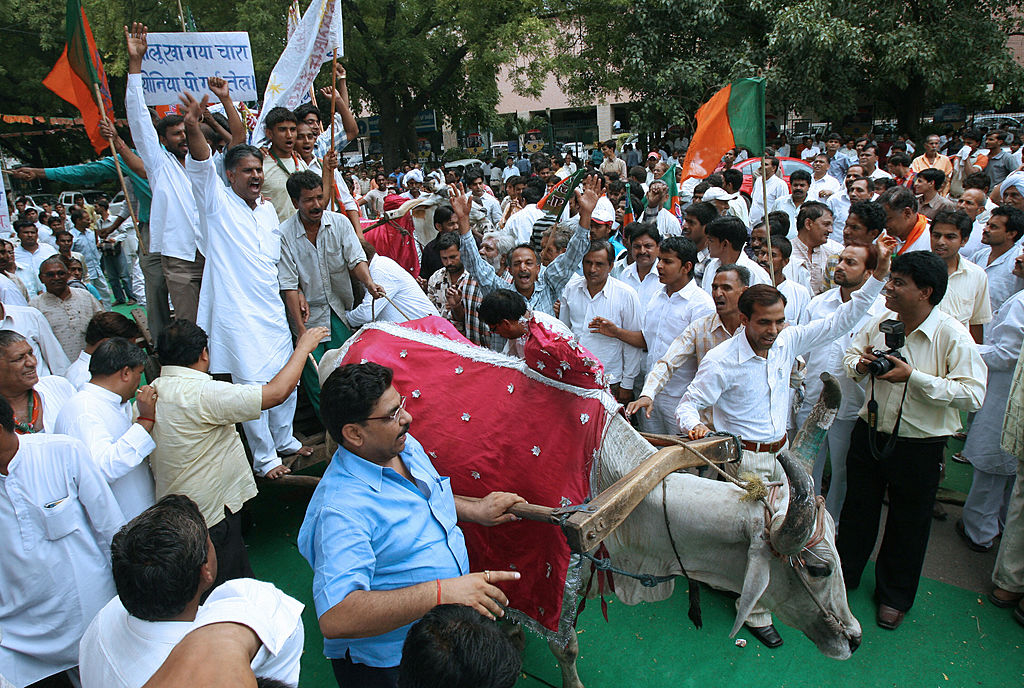- Monday, February 24, 2025

By: Shubham Ghosh
WITH fuel prices heading north, protests against the Narendra Modi government have become widespread in India. The protesters often resort to unique ways, ranging from burning effigies to pulling cars with ropes to cycling. But one of the most used tricks of protest has been riding bullock carts to criticise the rising prices of petrol and diesel. Nowadays, this has even opened business opportunities for people and they don’t really mind the skyrocketing fuel prices.
K K Soman, a businessman from Koothattukulam, a small town in Ernakulam district of the southern Indian state of Kerala, is one such individual. The man doesn’t complain about the continuous rise in the fuel prices since that adds to the demand for his bullocks that are regularly hired by politicians of the Left-ruled state to stage protests, Khaleej Times reported on Tuesday (13). It leaves Soman with a deeper pocket.
The protesting leaders often pose for the media by sitting on bullock carts to express their anger against the rising fuel prices. On Monday (12), for example, the local district Congress committee held a bullock cart protest after the prices of petrol crossed Rs 100 ($1.34)-a-litre mark.
According to one news report, two bullocks and the cart were transported in a vehicle along with five people to manage them and Soman ended up earning Rs 20,000 ($268) for the deal that lasted a day. He told the media that while keeps the animals in keeping with a family tradition, maintaining them is not cheap as it costs at least Rs 300 ($4.03) to Rs 400 ($5.37) a day. The income that Soman makes from renting away the bullocks for political protest gives him a welcome relief.
The pandemic had also made things tough for him. In the pre-Covid days, he used to give his bullocks to wedding parties when the bride and groom rode the carts. He used to charge them Rs 15,000 ($201) for hiring his bullocks. But the demand for his animals and the cart came down as the pandemic spread.
Protests add to animals’ plight
Symbolic protests against fuel price hike with bullock carts have been taking place across the country. But it has also added to the animals’ plights. Since several people join the protests eyeing a photo-opportunity, it adds to the pressure on the animals as the carts get overcrowded. On many occasions, the poor animals fail to move and collapse, hurting themselves.
The animal lovers are distraught. According to Khaleej Times, Sunish Subramanian, an animal welfare officer in Maharashtra, was so angry with Congress workers using a bullock cart to protest the fuel price hike in Mumbai earlier this week that left the animals fatigued and they eventually collapsed, that he asked the police to book the protesters under the Prevention of Animal Cruelty Act.
“They used a bullock cart for a protest and overcrowded it,” he told the media. “A bullock cart cannot take this much load. This is cruelty to animals. Politicians often use animals for protests. I have told the police to not allow anyone to use animals for protests or election campaigning.”
In another southern state of Telangana, a senior Congress leader also hired a bullock cart to protest the fuel hike. But the animals were terrified to see a large crowd and they dragged both the leader and his supporters down.
Rare footage from 1973 of an opposition protest when petrol prices were raised by seven Paise. Atal Bihari Vajpayee arrived in Parliament on a bullock cart (which would not be possible today with the new security restrictions on vehicle entry into the complex!) pic.twitter.com/1hd97kgoMG
— Shashi Tharoor (@ShashiTharoor) July 3, 2021
Using bullock carts in India to protest against the government over rising fuel prices is not new. Senior Congress member of parliament Shashi Tharoor tweeted earlier this month a rare video of former Indian prime minister Atal Behari Vajpayee riding a bullock cart to the parliament after fuel prices rose by seven paise. The video is from 1973 when the Congress was in power at the Centre.